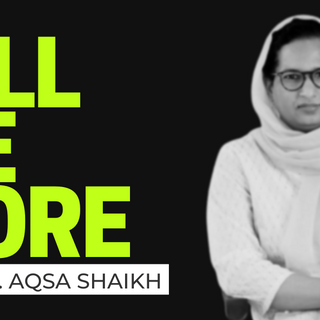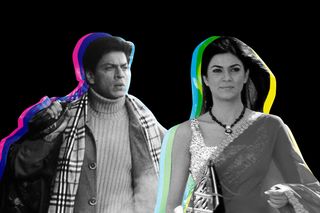
Can’t Let Go: Of the Candor of ‘Main Hoon Na,’ Despite Its Male‑Centric Plot
The movie is flawed — but depicts a nuanced idea of family, relationships, and societal identity.

In Can’t Let Go, we revisit the nostalgia around our favorite pop culture moments that haven’t aged well.
I begin this defense with a disclaimer: most older Indian cinema (and even now) is tainted with narrow ideas about beauty, femininity, and gender. Songs are sexist, portrayals are reductive, and the plot unfailingly focuses on the man and his perspective.
Main Hoon Na is not an exception to this criticism. A makeover scene with Amrita Rao (Sanjana) transforms the “tomboy” like character into the ‘perfect’ Indian woman with straight hair and ‘better’ clothes, after which Zayed Khan (Lucky) falls head over heels for her, like clockwork. Other similar clichés peppered through the movie made it a commercial hit 15 years ago. Now, we can’t help but note the complicity of Shah Rukh Khan (Ram) in furthering this sexism — for male attention, what else — or even the trope of the older female teacher Mrs. Kakkar who hits on her students. Patriarchy and its close friend sexism have a field day.
But looking back at these flaws also highlights some ways in which the movie tried to be self-reflective — as if it were making reparations in real-time.
Take the makeover scene. While it is still problematic, Sanjana calling out Lucky’s hypocrisy after was an important addition. Sanjana says what we’re all thinking: she became the object of Lucky’s attraction once she changed herself. And later, she did ditch the gulabi pink suit for her jeans and sweater combos. Through this, her character shined a light on the sexism and unfair gender expectations that start and end with her appearance.
Although the film is dominated by the stories of men (and the star power skewed to SRK in the ensemble cast), Sanjana’s character was allowed to be more than one-dimensional, with a backstory about imperfect family expectations. The fraught relationship between the father, who wanted a son, and a daughter, who got tired of disappointing him, didn’t play out as one would expect it to — where the daughter takes the first step to make amends or comes running to the family for good old-fashioned maafi.
The backstory establishes that it’s the father’s gender expectations that distance Sanjana until she leaves. Although he attempts to make amends, she is allowed to ignore them. Within the movie, Sanjana lives her life with fringed hems, bell bottoms, felt hats, crop-tops — solid fashion statements that survive till today, by the way — her life flourishing in a distant Darjeeling college, leaving her family background behind. While one could argue that her character essentially furthers another man’s story, the perspective is Sanjana’s — the decision lies with her. In the end, her father’s attempt at reconciliation isn’t used to write away the damage already done but to spell loud and clear: his weighted, sexist expectations were wrong.
Related on The Swaddle:
This was not the only unconventional family: Ram and Lakshman are step-sons in this set-up, where the mother Madhu (Kirron Kher) hates the ‘other’ son (Ram). Ram lies to them to win their love, gets caught, drama ensues. Some arguments, fight scenes, and a whole lot of brotherhood later, they reconcile as a family — despite the mother’s hatred. It’s hard to ignore that family — rooted firmly in the conventional in Indian cinema — gets a new definition: one that is not defined by blood, but by love. It’s a cheesy but important inference.
What’s intriguing is while the film had all elements of a commercialized plot, it still managed to blend complex relationships of family and friendship with a nationalistic dilemma — the bright, sweet romance is contrasted with the hidden threat of terrorism that threatens the former.
But if there was one, stand-alone winning element in the movie, it is Sushmita Sen’s screen presence as Chandni. While discussing the movie, a colleague noted unequivocally: “If Main Hoon Na is problematic, Sushmita Sen is reparations.”
The male-dominated narrative revolves around a lot of car chases and gravity-defying action, and while Sushmita Sen only has a handful of scenes, “the few scenes [SRK] has with Chandni serve to bring him down a few notches from being an alpha Army major out on a dangerous mission,” a film critic remembers saying. Sen towers over SRK — the macho man — with her “spunky and confident” character.
The saree aesthetic, coupled with her “Tumhe Jo Maine Dekha” performance (which is anecdotally accredited to many a queer awakening), also frame Chandni as a character who owns her sexuality, representing a freedom otherwise unseen in the Indian cinema. The positioning of Chandni as an empowered woman is also visible in how eventually she makes the first move on Ram — who is fumbling and awkward.
In the end, the movie radiates tempting warmth. A friend tells me it feels like a big hug — a little uncomfortable at times, but warm all the same. It is no wonder then that we can’t let go — of the complex relationships, the unlearning, and the famous Main Hoon Na whistle.
As Major Ram would say: Yeh zindagi nafrat ke liye bahut choti hain.
Saumya Kalia is an Associate Editor at The Swaddle. Her journalism and writing explore issues of social justice, digital sub-cultures, media ecosystem, literature, and memory as they cut across socio-cultural periods. You can reach her at @Saumya_Kalia.
Related


The Buzz Cut: Victoria’s Secret Launched New Brand Ambassadors In An Attempt to Be Relevant Again. Is It Too Little, Too Late?
